
Detail of Edward Crisp, A Compleat Description of the Province of CAROLINA in 3 Parts. 1st The Improved part from the Survey’s of Maurice Mathews & Mr. John Love. 2ly. the West part by Capt. Thos. Narin. 3ly A Chart of the Coast from Virginia to Cape Florieda. Colored engraving. 32 3/4" x 40". (Courtesy, South Caroliniana Library, University of South Carolina, Columbia, South Carolina; photo, Museum of Early Southern Decorative Arts.) This map was engraved by John Harris in London and published by Crisp about 1711.


Jacques Le Moyne de Morgue, Réné de Laudonniére and the Indian Chief Athore Visit Ribaut’s Column, probably Paris or London, 1564. 4" x 10". Gouache and metallic pigments on vellum. (Courtesy: Print Collection, Miriam and Ira D. Wallach division of Art, Prints and Photographs, The New York Public Library, Astor, Lenox and Tilden Foundations). Le Moyne was a member of the French expedition that settled at Fort Caroline on the St. John’s River in 1564. Although the colony failed in less than a year, Le Moyne survived and returned to Paris. In 1572, he escaped the Massacre of St. Bartholomew’s Day and fled to London. Encouraged by Sir Walter Raleigh, Le Moyne began drawing and painting plants, insects, and scenes of Indian life remembered from his voyage. His watercolor of commander Réné de Laudonniére and Chief Athore visiting the column erected by the first French expedition is an idyllic depiction of Europeans and Native Americans sharing the riches of the New World. This imagery must have held special meaning for Le Moyne and other Huguenots, who undoubtedly saw America as a place of opportunity and sanctuary (Jessie Poesch, The Arts of the Old South: Paintings, Sculpture, Architecture & the Products of Craftsmen, 1560–1860 [New York: Harrison House, 1983], pp. 3

Map of France showing birthplaces of Huguenot joiners who emigrated to Carolina. (Art work, Wynne Patterson.)
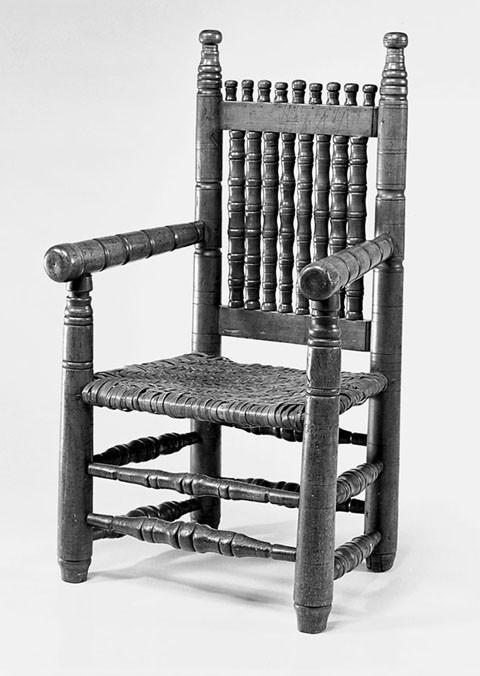
Armchair, coastal South Carolina, 1680–1700. Cherry with ash. H. 41 1/4", W. 23", D. 16 1/4". (Private collection; courtesy, Museum of Early Southern Decorative Arts.)


Detail of one of the pinned joints on the armchair illustrated in fig. 5.
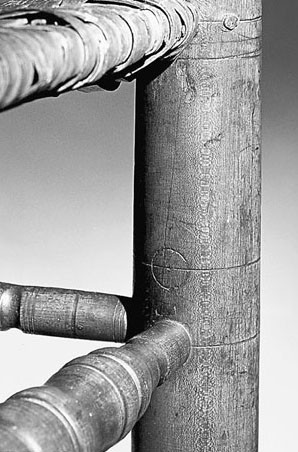
Detail of a partially cut mortise on the armchair illustrated in fig. 5. Another mortise about 1/8" deep also shows evidence of having been drilled with a center bit.
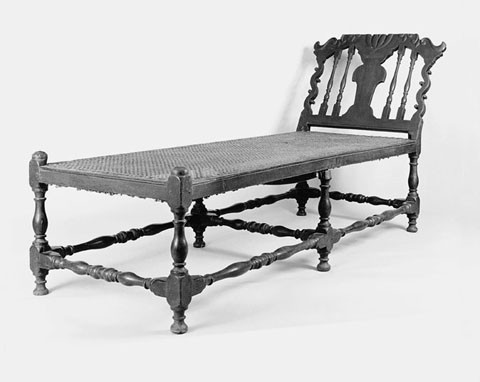
Couch, coastal South Carolina, 1700–1725. Walnut. H. 38 7/8", W. 27 1/4" (seat), L. 80 3/4". The upper portion of the crest rail is missing. (Collection of the Museum of Early Southern Decorative Arts.)

Detail of the back of the couch illustrated in fig. 9.

Gateleg table, probably New York City, 1700–1725. Mahogany with maple and tulip poplar. H. 30 1/8"; top: 58" x 72 1/4" (open). (Courtesy, Historic Hudson Valley, Tarrytown, New York; photo, Gavin Ashworth.) The original owners may have been Philip Van Cortlandt (1683–1748) and his wife, Catherine De Peyster (1688–ca. 1766), who were married in 1710.
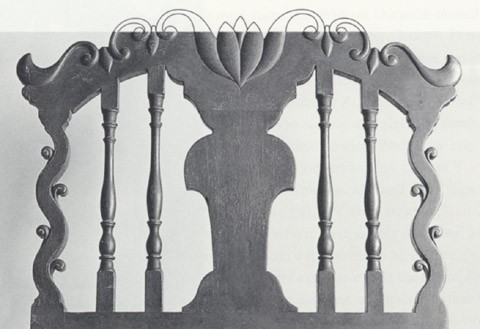
Conjectural drawing of the back of the couch illustrated in fig. 9, showing how the missing carved components on the crest rail probably appeared. (Drawing by Luke Beckerdite, artwork by Wynne Patterson.)
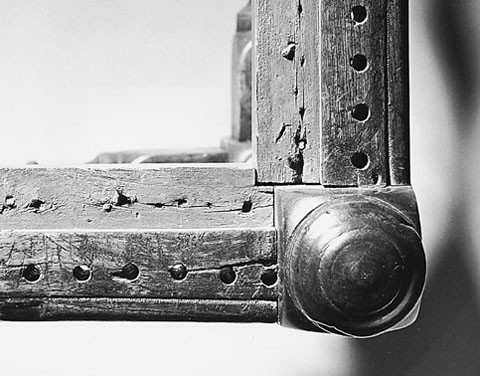
Detail of the nailing evidence for a sacking bottom on the rails of the couch illustrated in fig. 9. The holes adjacent to the beaded edges are from a later cane bottom.
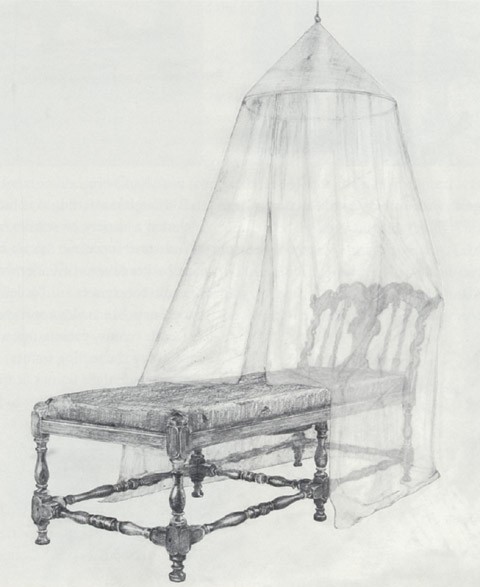
Conjectural drawing of a pavilion based on diagrams in Peter Thornton, Seventeenth-Century Interior Decoration in England, France and Holland (New Haven, Conn.: Yale University Press, 1978), p. 158. (Artwork by Wynne Patterson.)

Armchair, possibly coastal South Carolina, 1690–1720. Walnut. H. 45 1/2" (feet restored), W. 22", D. 16 3/4". This chair originally had a plank seat. During the nineteenth or early twentieth century, the seat boards were removed and the upper edges of the beaded seat rails were rounded to accommodate a woven seat. (Courtesy, Colonial Williamsburg Foundation.)


Armchair, probably New York City, 1685–1700. Maple stained red. H. 44", W. 22 1/2", D. 17 1/4". (Private collection; photo Christopher Zaleski.)

Escabeau, Charleston, South Carolina, 1695–1725. Cypress. H. 24 3/4", W. 15 1/4", D. 113/4". (Collection of the Museum of Early Southern Decorative Arts.)
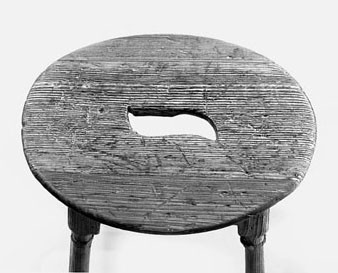
Detail of the top of the escabeau illustrated in fig. 18.

Escabeau, Quebec, 1690–1700. Birch, maple, and pine. H. 22 5/8". (Courtesy, Historic Deerfield.)

Gateleg table, Charleston, South Carolina, 1690–1710. H. 29 1/2"; top: 52 1/4" x 67 1/8" (open). Cypress and red cedar. (Courtesy, The Charleston Museum, Charleston, South Carolina; photo, Gavin Ashworth.) charlestonmuseum.org

Detail of a batten on the gateleg table illustrated in fig. 21. (Courtesy, The Charleston Museum, Charleston, South Carolina; photo, Gavin Ashworth.) charlestonmuseum.org

Detail of the end of a batten on the gateleg table illustrated in fig. 21. (Courtesy, The Charleston Museum, Charleston, South Carolina; photo, Gavin Ashworth.) charlestonmuseum.org

Gateleg table, northern Europe, 1680–1720. Red pine. H. 28 1/2"; top: 38" x 67 1/4" (open). (Courtesy, Charleston Museum; photo, Gavin Ashworth.) Damage to the rail below the replaced drawer suggests that the original was missing for some time; however, the current cypress drawer appears to be an early eighteenth-century Carolina replacement. The battens under the leaves are chamfered and dovetailed in the same manner as those illustrated in figs. 22 and 23. The turnings of this table are very similar to those on late seventeenth-century chairs from southwestern France. (Courtesy, The Charleston Museum, Charleston, South Carolina; photo, Gavin Ashworth.) charlestonmuseum.org


Henrietta Johnston, Thomas Broughton, Charleston, South Carolina, 1710–1711. Crayon on paper. 10 5/8" x 7 3/4". (Private collection; photo, Museum of Early Southern Decorative Arts.)

Detail of a leg, ogee-molded top, and a dovetailed cleat on the table illustrated in fig. 25.

Thomas Coram, View of Mulberry, House and Street, painted in Charleston or Berkeley County, South Carolina, 1805. Oil on paper. 4 1/16" x 61 1/16". (Courtesy, Gibbes Museum of Art/Carolina Art Association, 68.18.01; photo, Museum of Early Southern Decorative Arts.)

Mulberry, Berkeley County, South Carolina, ca. 1714. (Photo, Gavin Ashworth.)

Detail of a second-floor room in Mulberry. (Photo, Gavin Ashworth.)

Detail of the central panel of the door illustrated in fig. 30. (Photo, Gavin Ashworth.)

Buffet bas, Quebec, ca. 1700. Red pine painted red. H. 39 3/4", W. 41 5/8", D. 19". (Courtesy, Historic Deerfield.)
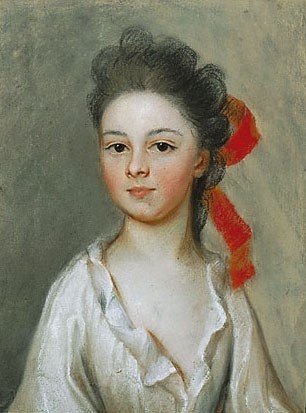
Henrietta Dering Johnston, Henriette Charlotte de Chastaigner, 1700-1754. Pastel on paper. 11 5/8" x 8 7/8". (Courtesy, Gibbes Museum of Art/Carolina Art Association, 38.20.04; photo, Museum of Early Southern Decorative Arts.)

Limrick, Berkeley County, South Carolina, ca. 1711. (Courtesy, Library of Congress.)

Detail of the stair in Limrick. (Courtesy, Library of Congress.)
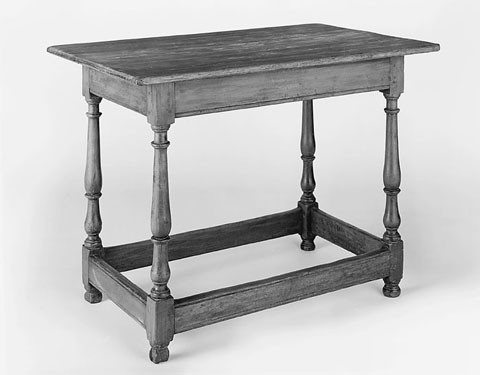
Table, probably Berkeley County, South Carolina, ca. 1711. Cypress with traces of original red paint. H. 27 7/8", W. 36 3/16", D. 23 1/4". (Courtesy, The Charleston Museum, Charleston, South Carolina; photo, Gavin Ashworth.) charlestonmuseum.org
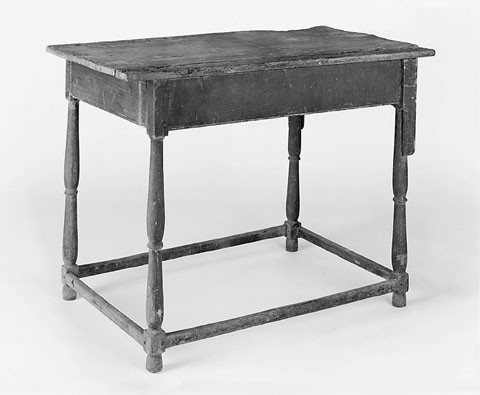
Table, coastal South Carolina, 1780–1820. Cypress painted blue. H. 28 1/4", W. 37 1/2", D. 22 1/2". Courtesy, The Charleston Museum, Charleston, South Carolina; photo, Gavin Ashworth.) charlestonmuseum.org

Dressing table, probably Charleston, South Carolina, 1700–1720. Mahogany with red bay. H. 28", W. 32 3/4", D. 18 1/2". (Courtesy, Colonial Williamsburg Foundation.)

Table, probably Charleston, South Carolina, 1700–1720. Cypress painted black. H. 27 5/8", W. 26", D. 21". (Collection of the Museum of Early Southern Decorative Arts.)

Table, coastal South Carolina, 1700–1720. Walnut and tulip poplar with yellow pine. H. 29 1/2", W. 27 1/2", D. 21 1/4". (Courtesy, National Park Service, George Washington Birthplace National Monument, GEWA20433; photo, Museum of Early Southern Decorative Arts.)
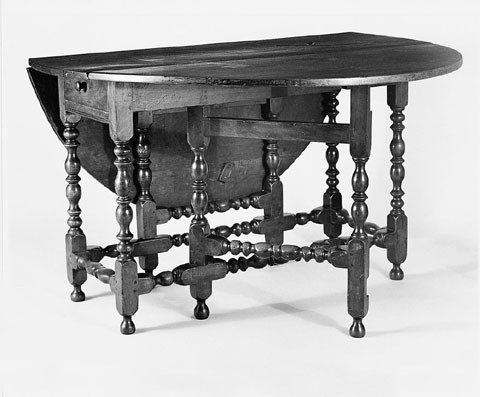
Gateleg table, Charleston, South Carolina, 1700–1725. Walnut with yellow pine and cypress. H. 291/2"; top: 47 3/4" x 57 1/2". (Collection of the Museum of Early Southern Decorative Arts.)

Henrietta Johnston, Samuel Prioleau, Charleston, South Carolina, 1715. Crayon on paper. 12" x 9". (Collection of the Museum of Early Southern Decorative Arts.)

Henrietta Johnston, Susanne Le Noble, Charleston, South Carolina, 1710. Crayon on paper. 10 7/8" x 6 3/4". (Private collection; photo, Museum of Early Southern Decorative Arts.)

Sacramental plate for Biggin Church, St. John’s Parish, South Carolina, including: (a) Standing cup by Miles Brewton, Charleston, South Carolina, ca. 1711. Silver. H. 7 5/8". Silver gilt. Dimensions unrecorded. (Courtesy, Museum of Early Southern Decorative Arts.)

Sacramental plate for Biggin Church, St. John’s Parish, South Carolina, including: (b) Paten by Miles Brewton, ca. 1711. Silver. H. 2 15/16", Diam. 5 3/4". Silver gilt. Dimensions unrecorded. (Courtesy, Museum of Early Southern Decorative Arts.)

Sacramental plate for Biggin Church, St. John’s Parish, South Carolina, including: (c) Cup, Paris, seventeenth century. Silver gilt. Dimensions unrecorded. (Courtesy, Museum of Early Southern Decorative Arts.)

Dressing table, Charleston, South Carolina, 1725–1735. Walnut. H. 31 5/8", W. 3 13/4", D. 21". (Collection of the Museum of Early Southern Decorative Arts.) The dressing table has an illegible inscription written in French.
